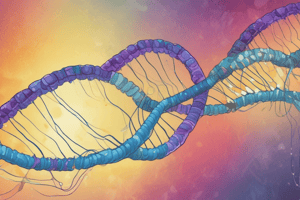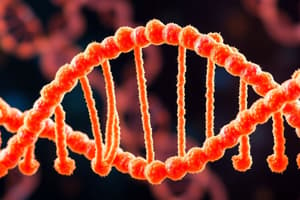Podcast
Questions and Answers
What is the function of mRNA in a cell?
What is the function of mRNA in a cell?
- Participates in various RNA processing pathways
- Aids in ribosome function during translation
- Encodes genetic information for amino acid sequences in proteins (correct)
- Decodes mRNA during translation
How does tRNA contribute to protein synthesis?
How does tRNA contribute to protein synthesis?
- Decodes mRNA, carrying specific amino acids to the ribosome during translation (correct)
- Encodes genetic information for amino acid sequences in proteins
- Aids in ribosome function during translation
- Regulates gene expression at the post-transcriptional level
Which type of RNA participates in ribosome function during translation?
Which type of RNA participates in ribosome function during translation?
- snRNA
- tRNA
- mRNA
- rRNA (correct)
What is a potential consequence of RNA mutations in non-coding RNA molecules?
What is a potential consequence of RNA mutations in non-coding RNA molecules?
Which RNA molecule regulates gene expression at the post-transcriptional level?
Which RNA molecule regulates gene expression at the post-transcriptional level?
How can mutations in RNA molecules contribute to disease and disorders?
How can mutations in RNA molecules contribute to disease and disorders?
What is the primary function of messenger RNA (mRNA)?
What is the primary function of messenger RNA (mRNA)?
Which component of transfer RNA (tRNA) is responsible for pairing with mRNA's codons?
Which component of transfer RNA (tRNA) is responsible for pairing with mRNA's codons?
What type of bonding allows RNA molecules to form secondary structures?
What type of bonding allows RNA molecules to form secondary structures?
What are the nitrogenous bases found in RNA molecules?
What are the nitrogenous bases found in RNA molecules?
Which type of RNA is responsible for decoding mRNA during translation?
Which type of RNA is responsible for decoding mRNA during translation?
How does mRNA contribute to protein synthesis in cells?
How does mRNA contribute to protein synthesis in cells?
Flashcards are hidden until you start studying
Study Notes
Exploring RNA: The Building Blocks of Life
RNA, or ribonucleic acid, is a crucial component of life, playing a central role in the functioning of cells. To understand RNA's diverse roles, we'll examine two primary types—mRNA and tRNA—as well as the structure and function of RNA molecules and the consequences of RNA mutations.
Messenger RNA (mRNA)
Messenger RNA carries genetic information from DNA to the cellular machinery responsible for protein synthesis. mRNA molecules are transcribed from DNA templates and are then translated by ribosomes into proteins. mRNA is the bridge between the genetic code and the cellular processes that it controls.
Transfer RNA (tRNA)
Transfer RNA is responsible for decoding mRNA during translation. tRNA molecules carry specific amino acids and contain a specific sequence of nucleotides called the anticodon, which pairs with the mRNA's codons. tRNA molecules can be thought of as the language interpreters between the genetic code and protein synthesis.
RNA Structure
RNA molecules consist of a linear chain of nucleotides. These nucleotides are made up of a sugar molecule (ribose), a phosphate group, and one of four nitrogenous bases—adenine (A), uracil (U), cytosine (C), and guanine (G). RNA molecules can form secondary structures through hydrogen bonding between bases. RNA molecules can also fold into unique three-dimensional conformations, which are essential for their function.
RNA Function
RNA molecules perform several functions:
- mRNA—encodes genetic information for amino acid sequences in proteins.
- tRNA—decodes mRNA, carrying specific amino acids to the ribosome during translation.
- rRNA—aids in ribosome function during translation.
- snRNA—participates in various RNA processing pathways.
- miRNA—regulates gene expression at the post-transcriptional level.
- lncRNA—functions in various processes, including transcriptional regulation and chromatin modification.
RNA Mutations
Mutations in RNA molecules can have significant consequences on cellular processes. Some consequences of RNA mutations include:
- Incorrect protein synthesis—can lead to the production of non-functional proteins or proteins with altered functions.
- Regulatory effects—mutations in non-coding RNA molecules can impact gene expression and cellular processes.
- Disease and disorders—RNA mutations contribute to various diseases, including cancer, neurological disorders, and genetic diseases.
RNA is a dynamic and versatile molecule, playing a crucial role in life's processes. Understanding the structure and function of RNA, as well as the consequences of RNA mutations, provides a fundamental grasp of the molecular mechanisms that drive the world of biology.
Studying That Suits You
Use AI to generate personalized quizzes and flashcards to suit your learning preferences.




